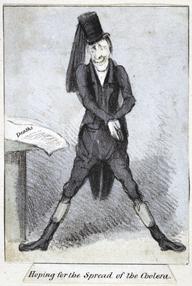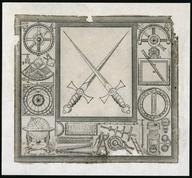





'Diagrams Are A Girl's Best Friend' three-colour print by Adam Dant, 2020. Against a pink background, Nightingale stands holding a lamp in her left hand, which acts as the centre of a polar area graph. Nightingale and diagram are in yellow and white. 'Diagrams' appears to centre above, and 'a girls best friend' [sic] to bottom right. The print was made using linoleum and the apostrophe mistakenly lost from 'girls'. Signed and dated bottom right, edition 12/100 bottom left.
Adam Dant’s striking and humorous print commemorates the bicentenary of the birth of legendary nurse, statistician, and social reformer Florence Nightingale. Conceived in collaboration with the University of Oxford’s Department of Statistics, the print was intended to promote public engagement with statistics and infectious disease epidemiology. It's production in 2020 also serves to commemorate the Coronavirus pandemic and re-enforce the importance of analysing and understanding disease data.
Dant combines both popular and scientific visual iconography associated with Nightingale alongside a feminist joke. She appears with the trademark lamp, with which she was known to do rounds of the Crimean war hospitals visiting wounded soldiers earning the nickname ‘The Lady with the Lamp’. The lamp then serves as the centre of a polar area graph, allowing the sections of the graphic to appear like shafts of light emanating from the lamp. These graphs were invented by Nightingale in 1858 with the help of William Farr to highlight the number of unnecessary deaths during the Crimean War from preventable infections. It is Nightingale’s most well-known statistical illustration. Dant stresses the importance of such diagrams in furthering both Nightingale’s career and medical knowledge, by riffing on the famous phrase ‘Diamonds are a girl’s best friend’ taken from the Broadway song of 1949 and made famous by Marilyn Monroe in the 1953 film 'Gentlemen prefer blondes'. This could be a rallying call for girls engaging with STEM.
In keeping with Dant’s unusual approach to print making, the materiality of this three-colour print is as significant as its imagery. The limited edition of 100 prints was produced using a piece of antique linoleum from the old Middlesex Hospital where Nightingale worked as a nurse during the cholera outbreak in Broad Street, Soho in 1854. The apostrophe in ‘girls’ came loose during printing but perhaps now stands for the confusion induced in 2020 by the onset of the coronavirus pandemic. Dant was working on this print during the period of daily governmental briefings on COVID-19 data when Oxford’s Department of Statistics was busy tracking cases and projecting future incidence. Nightingale planned with her friend Benjamin Jowett, Master of Balliol College, to co-found a Chair of Statistics at Oxford, which was sadly never realized during their lifetimes.
Details
- Category:
- Art
- Object Number:
- 2021-499
- Materials:
- paper (fibre product) and ink
- Measurements:
-
overall: 315 mm x 226 mm
- type:
- copyright:
- Dant, Adam
- credit:
- courtesy of the artist and TAG Fine Arts




